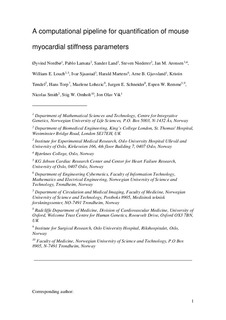| dc.contributor.author | Nordbø, Øyvind | |
| dc.contributor.author | Lamata, P. | |
| dc.contributor.author | Land, Sander | |
| dc.contributor.author | Niederer, Steven A. | |
| dc.contributor.author | Aronsen, Jan Magnus | |
| dc.contributor.author | Louch, William Edward | |
| dc.contributor.author | Sjaastad, Ivar | |
| dc.contributor.author | Martens, Harald | |
| dc.contributor.author | Gjuvsland, Arne Bjørke | |
| dc.contributor.author | Tøndel, Kristin | |
| dc.contributor.author | Torp, Hans | |
| dc.contributor.author | Lohezic, M | |
| dc.contributor.author | Schneider, Jürgen | |
| dc.contributor.author | Remme, Espen W. | |
| dc.contributor.author | Smith, Nicolas P | |
| dc.contributor.author | Omholt, Stig W | |
| dc.contributor.author | Vik, Jon Olav | |
| dc.date.accessioned | 2017-10-26T12:17:14Z | |
| dc.date.available | 2017-10-26T12:17:14Z | |
| dc.date.created | 2014-10-06T19:12:29Z | |
| dc.date.issued | 2014 | |
| dc.identifier.citation | Computers in Biology and Medicine. 2014, 53 65-75. | nb_NO |
| dc.identifier.issn | 0010-4825 | |
| dc.identifier.uri | http://hdl.handle.net/11250/2462376 | |
| dc.description.abstract | The mouse is an important model for theoretical–experimental cardiac research, and biophysically based whole organ models of the mouse heart are now within reach. However, the passive material properties of mouse myocardium have not been much studied. We present an experimental setup and associated computational pipeline to quantify these stiffness properties. A mouse heart was excised and the left ventricle experimentally inflated from 0 to 1.44 kPa in eleven steps, and the resulting deformation was estimated by echocardiography and speckle tracking. An in silico counterpart to this experiment was built using finite element methods and data on ventricular tissue microstructure from diffusion tensor MRI. This model assumed a hyperelastic, transversely isotropic material law to describe the force–deformation relationship, and was simulated for many parameter scenarios, covering the relevant range of parameter space. To identify well-fitting parameter scenarios, we compared experimental and simulated outcomes across the whole range of pressures, based partly on gross phenotypes (volume, elastic energy, and short- and long-axis diameter), and partly on node positions in the geometrical mesh. This identified a narrow region of experimentally compatible values of the material parameters. Estimation turned out to be more precise when based on changes in gross phenotypes, compared to the prevailing practice of using displacements of the material points. We conclude that the presented experimental setup and computational pipeline is a viable method that deserves wider application. | nb_NO |
| dc.language.iso | eng | nb_NO |
| dc.rights | Attribution-NonCommercial-NoDerivatives 4.0 Internasjonal | * |
| dc.rights.uri | http://creativecommons.org/licenses/by-nc-nd/4.0/deed.no | * |
| dc.title | A computational pipeline for quantification of mouse myocardial stiffness parameters | nb_NO |
| dc.type | Journal article | nb_NO |
| dc.type | Peer reviewed | nb_NO |
| dc.description.version | acceptedVersion | nb_NO |
| dc.source.pagenumber | 65-75 | nb_NO |
| dc.source.volume | 53 | nb_NO |
| dc.source.journal | Computers in Biology and Medicine | nb_NO |
| dc.identifier.doi | 10.1016/j.compbiomed.2014.07.013 | |
| dc.identifier.cristin | 1161735 | |
| dc.relation.project | Stiftelsen Kristian Gerhard Jebsen: SKGJ-MED-005 | nb_NO |
| dc.relation.project | Norges forskningsråd: 178901 | nb_NO |
| dc.relation.project | Notur/NorStore: NN4653K | nb_NO |
| cristin.unitcode | 192,15,0,0 | |
| cristin.unitcode | 192,10,1,0 | |
| cristin.unitname | Realfag og teknologi | |
| cristin.unitname | Institutt for husdyr- og akvakulturvitenskap | |
| cristin.ispublished | true | |
| cristin.fulltext | postprint | |
| cristin.qualitycode | 1 | |

